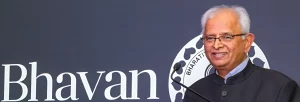(April 23, 2024) There is an all-pervasive energy that abounds when 56-year-old Rahul Mitra speaks. It is little wonder that the Hyderabad-born and Houston-based artist is also a scientist and award-winning writer.
The multi-faceted professional helped develop therapeutics for ovarian cancer that are now in clinical trials, and as an artist, uses visual language drawn from his experience to interpret personal and socio-political dialogues – exploring various facets of life from love to technology. Working across different media, from oils and acrylics to figurative art and installations, he focuses on studying the underbelly of global cultures.

Rahul Mitra
His work has been widely exhibited across the world, including the First Printmaking Triennial of ULUS in Serbia, the Texas Biennial, the India Art Fair, the Contemporary Arts Museum Houston, the Portland Museum of Art, and the Centre Pompidou, amongst others. Visually striking with bold colors and with themes that are universal in nature, the artist’s work is appealing both visually and cerebrally.
Shaped by early experiences
Growing up in Hyderabad in the 1970s, Rahul Mitra was deeply influenced by his surroundings. Always interested in drawing and sketching, he remembers art and culture as an integral part of life. From classical musicians playing in the streets where everyone assembled in the evenings, burra kathas in the neighborhood, and screenings of mythological films via projectors in temples, he was shaped very early by art.
“Culture back then was simply on the street and literally all around you,” recalls the Global Indian and adds, “Most calendar art was influenced by religious texts, and it was a simpler time when most people did not have much money (it was socialist India after all), but the quality of life was much better.”
What cemented his interest further was the legendary Hyderabad artist Surya Prakash’s studio, which he used to visit. “He was my friend (now the filmmaker) Nagesh Kukunoor’s neighbor in our colony, and I used to go see his works. He used to spread them on the floor, making it an impressive sight,” he recalls.
Opportunity came early on via an unexpected source. His teacher, on noticing his impressive drawings, recommended that he illustrate a book in the NCERT curriculum, and his mentor then was a teacher who worked in the local school. The artist smiles and says, “I used to go to the school after hours where my art teacher used to work in the corridors, and it was a sight to behold, with the entire area drenched in color. I still remember using water colors to work with, which is a difficult medium at best.”
View this post on Instagram
Hyderabad was then a small, sleepy, and green city that shaped the young artist’s mind. Another memorable experience was traveling on trains and observing people and society, which left an indelible mark on his consciousness. The artist recalls going to Vijayawada frequently, even as a teenager, as his father owned a printing press in the town and was amazed by the statues of Lenin and Stalin that were at street corners, which gave him a world view very early on.
It was this outlook that fed his mind and soul, as well as his art. Mitra’s work is deeply influenced by socio-political issues he witnessed in his childhood, including the disparities between the rich and poor, the macro- and micro-issues that society faces, and dual identities; all of this still forms the crux of his inspiration.
The flight to United States
Fate, however, had different plans for him, as he went to the US in 1990 (after studying at IIT Roorkee) and pursued his PhD in Biochemistry and Molecular Biology at the University of Maine before working as a scientist. He held various posts of distinction, including that of Director of the non-coding RNA Cancer Center at the prestigious MD Anderson Cancer Center in Houston, USA, where he helped develop therapeutics for ovarian cancer that are now in clinical trials.
Life in the US in the early 1990s was exciting for the scientist turned artist. He shares, “I was so excited to see a new culture. Yes, food was difficult, but I was resourceful and started cooking. There were fewer Indians, and in Maine, I was considered exotic, but life was fun.”
Even in all those busy years, Mitra never really gave up painting. Juggling a marriage and a high-pressure job was not easy, but he did it. “I’m wired that way. I sleep only for three-four hours, so it never seemed like I had a long day. I always appreciated my work—be it looking for ink for my fountain pen or meeting an artist—everything I do, I do it with passion,” he smiles.
View this post on Instagram
From the scientific to the artistic world
It was this passion that, in 2008, made Rahul Mitra return to art after a visit to the Venice Biennale inspired him. His first show, Dialogues of Civilization, held at G Gallery in Houston, was very well received and ensured that he never looked back. What the artist achieved through his work was to showcase the disparities that are prevalent in all societies, from the caste system in India to racial injustice in the West. It is this raw energy that makes one think while viewing his art.
“I want my art to raise questions and implore people to look within. There are many things that go undocumented in history. My aim is to focus on issues like those that are uncomfortable and compel us to look around us. I’m influenced by early European art but viewed with the lens of my Telangana roots,” he states.
His current show, The Elephant in the Room, in acrylic and oils, showcases elements of Hyderabad juxtaposed against the issues it faces. From autos to arches of religious structures to issues of colonialism and modernization, they provoke the viewer to think. Deeply metaphorical, his work captures the issues modern societies grapple with, from lopsided urban development to gender disparities.

One of Rahul Mitra’s works
His visual vocabulary is unique, as is his process of work. He first makes rough sketches of his work before using digital collages to get an impression of what the finished art looks like before he executes his vision on the canvas. Also passionate about public installations, the artist has worked on multiple projects using materials as simple as cartons and wood, creating deeply impactful works, which Rahul Mitra calls the Box City.
Love for India and its heritage
In all things creative, including writing, the author has never let his roots in India fade away. They form his constant muse and forever inspiration.
As someone who has been based out of the US for over three decades, how has life changed for Indians in the country? He smiles. “After the internet took off, I think Indians are looked at with much respect. Most Indians are highly educated and contribute actively to society.”
How much has changed for Indians pursuing the American dream from the 90s to now? He ponders before answering with a laugh, “Technology has revolutionized life. Back then, I used to pay three dollars to call for a minute. Now, it’s free, so younger students can feel closer to their parents. It reminds me of the old movies when magicians could see people in the mirrors at the chant of a mantra, just that the iPhone has replaced the mirror.”

Rahul Mitra with his family
With a lawyer wife Mini Kapoor and artistically inclined children Anika (who works with Deloitte in New York) and Manav (who has just finished high school), the artist is in a happy space. For someone who loves traveling, cooking, and collecting comics with his family, his next goal is all ready—to find a publisher for his manuscript!
- Follow Rahul Mitra on Instagram





Proud on you dear Rahul
This journey is amazing as well as motivating.
Salutes to you Rahul!